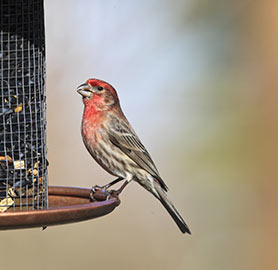
House Finch
Posted by Grange Co-op on 28th Dec 2014
Male: Red on crown, throat and upper breast, (in some regions red can be orange or yellow), broad blurry brown streaking on lower breast, flanks, wings, and back.
Female: Uniformly brown-streaked throughout.
 NESTING:
NESTING:
Cup nest of twigs, grasses, leaves and debris, placed in a variety of artificial and natural cavities, such as foundation shrubs, vines, hanging planters and occasionally birdhouses. 4-5 bluish white eggs lightly speckled. 2 broods per year incubated by female. Incubating female fed by male.
FEEDING:
Forages on ground and in shrubbery for small insects, weed seeds, blossoms, fruit, and leaf buds. Can monopolize bird feeders in small flocks where it prefers black oil sunflower seed. Also seen eating safflower seed and Nyger®.
RECOMMENDED ROGUE SEED:
Black oil sunflower, Rogue Premium, Rogue Chickadee, Rogue Deluxe, sunflower chips. Shop Wild Bird Food.
RECOMMENDED FEEDERS:
Forever sunflower feeder, Magnum sunflower feeder, any seed tube feeder, No-No feeders. Shop Wild Bird Feeders.
HABITAT:
Residential urban and suburban areas, parks, open fields and woodlands. Common year-round resident throughout the US.
OTHER INTERESTING FACTS:
Very social bird, forms winter flocks. Native to the western states. Introduced to the East in New York when pet dealers, being arrested for illegally selling House Finches as “Hollywood Finches”, released the birds. Now found throughout all lower 48 states and southern Canada. Suffers a fatal eye disease that causes the eyes to crust over. Cleanliness of feeders and the ground underneath is important. Their song is a musical warble often ending with a harsh down-slurred “jeeer.” Both female and male sing.
COMPARE TO:
Purple Finch: males tend to be more raspberry red rather than orange-red, little brown streaking on breast. Most easily distinguished by female featuring a bold white eyebrow stripe.
Cassin’s Finch: males are a more rosy red, larger bill, and belly has no obvious brown streaking, habitat in conifers in upper mountains.
Would you like to attract birds to your yard? We’ve got a great selection of products to help you and your feathered friends get together. Shop our Wild Bird department now.
